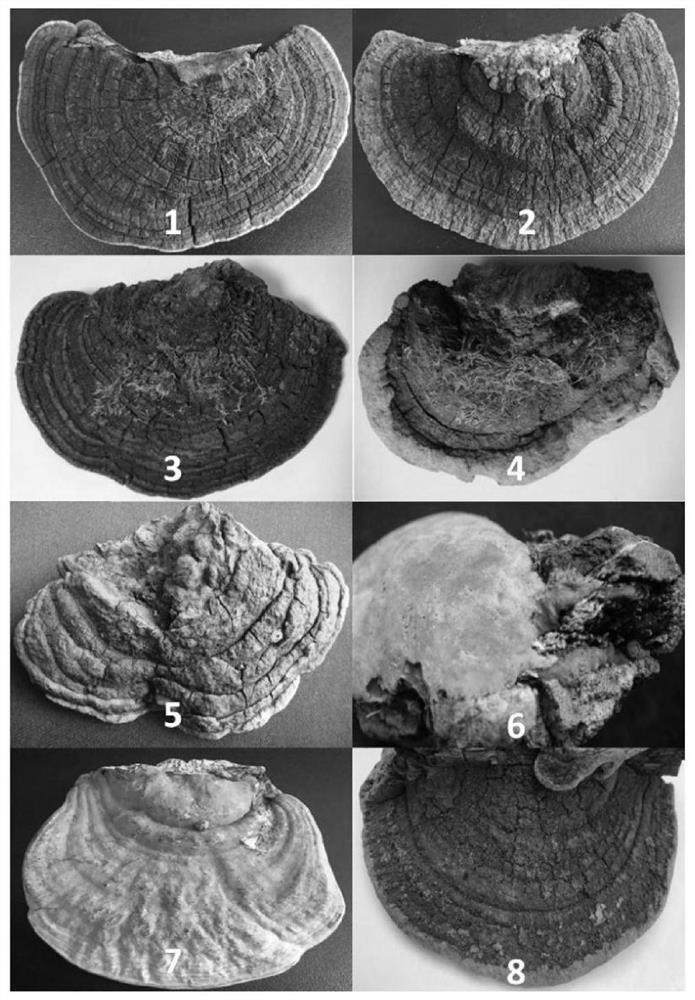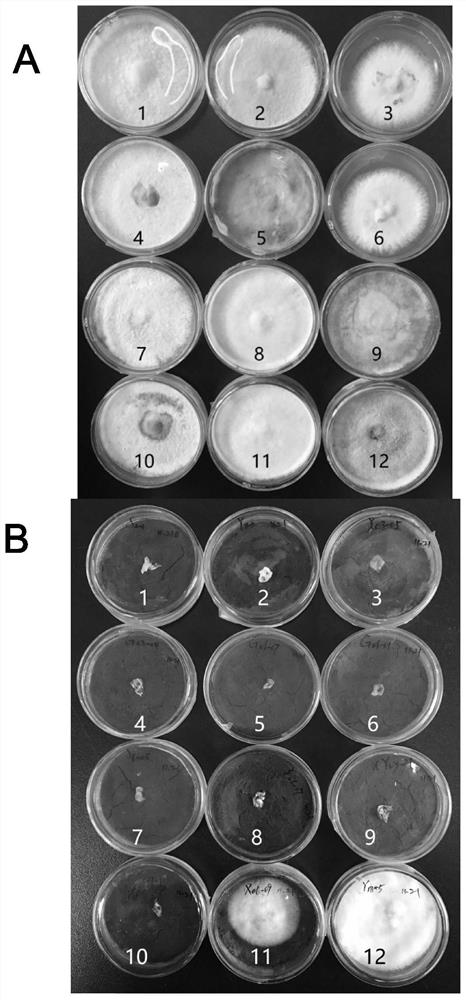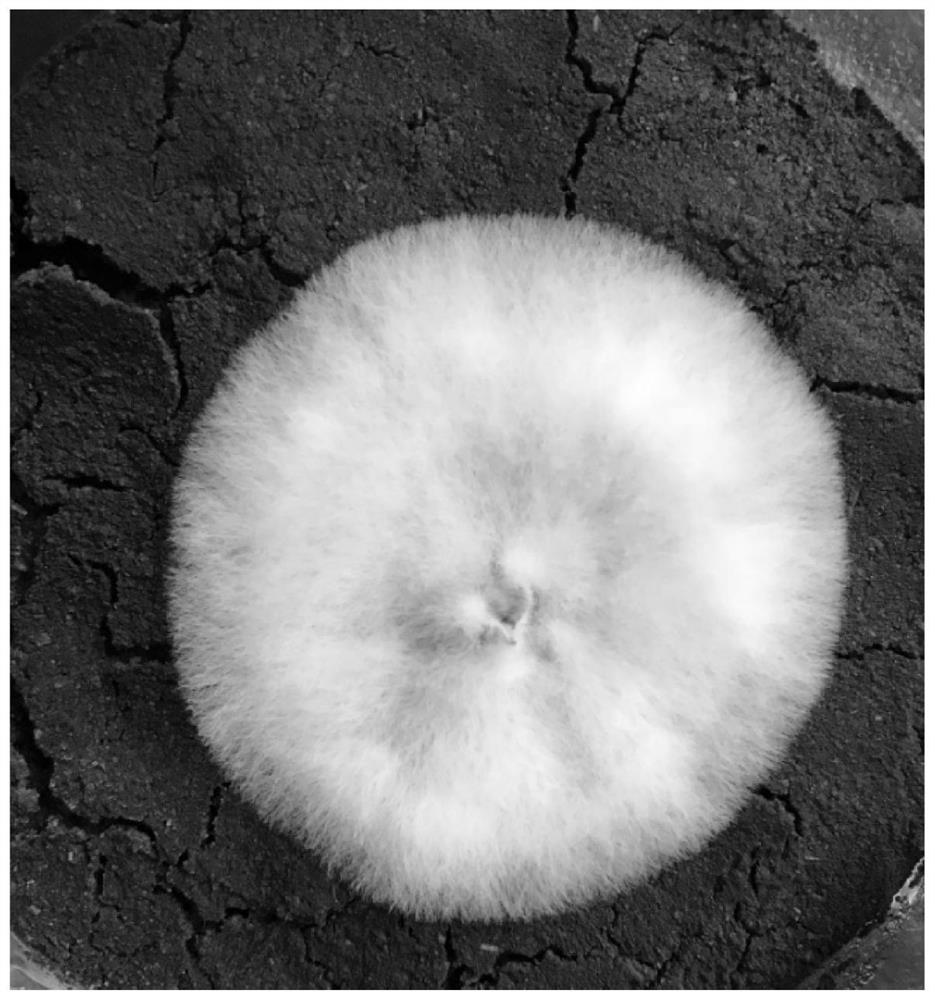A kind of culture medium for identification of Phellinus mulberry and its preparation method and application
An identification method and culture medium technology, which are applied in the field of medium production, can solve the problems of Phellinus japonica confusion, restriction of Phellinus japonica development, and difficulty in becoming stable Phellinus japonica, and achieve low cost, strong operability, and simple identification method Effect
- Summary
- Abstract
- Description
- Claims
- Application Information
AI Technical Summary
Problems solved by technology
Method used
Image
Examples
Embodiment 1
[0049] Embodiment 1, Morus Phellinus Phellinus and other strains are isolated and cultivated
[0050] (1) Retrieve the yellow sessile fungi that are often mistaken for Phellinus Phellinus in the literature and the Internet (Table 1); the fruiting bodies of Phellinus Phellinus and various fruiting bodies that are easily confused with Phellinus Phellinus ( figure 1 ).
[0051] Table 1: Phellinus mulberry and various fruiting bodies that are easily confused with Phellinus mulberry
[0052]
[0053]
[0054] (2) Isolate the above-mentioned various sporocarp strains and temporarily store them in PDA medium. Above-mentioned strains all can grow smoothly in PDA culture medium, only from aspects such as color, shape, smell, can't accurately distinguish which one is the true mulberry Phellinus ( figure 2 A).
Embodiment 2
[0055] Embodiment 2, mulberry Phellinus identification medium making
[0056] (1) Take the fresh silkworm excrement from the day before the 5th instar silkworm, and the silkworm is required to be healthy and disease-free, and the silkworm excrement is pure (only a small amount of broken mulberry leaves eaten by silkworms, without any anti-stiffness powder and lime and other sericulture medicines) );
[0057] (2) Get a 5-mesh sieve, initially sieve fresh silkworm excrement, and remove larger broken mulberry leaves;
[0058] (3) Dry at 60°C for 10 hours, select by air once with an electric fan, and manually select again with tweezers to remove smaller mulberry leaf debris;
[0059] (4) Place in a 150-mesh sieve, wash once with clear water, and further remove the fine mulberry leaf debris attached to the surface of the silkworm excrement to obtain pure silkworm excrement before the 5th instar (without any other impurities except the silkworm excrement).
[0060] (5) Dry again a...
Embodiment 3
[0063] Embodiment 3, mulberry Phellinus identification
[0064] (1) Pick the above-mentioned various bacterial strains grown in the PDA medium, transfer them to the above-mentioned mulberry Phellinus identification medium, and seal with a parafilm.
[0065] (2) Culture in complete darkness at 28°C for 10-12 days.
[0066] (3) Under the above-mentioned culture conditions, only the mycelium of Phellinus mulberry can grow normally in the above-mentioned medium, while the tree species parasitic by other strains tested are not mulberry, and they cannot grow normally in the identification medium of Phellinus mulberry ( figure 2 B).
[0067] (4) the Phellinus mulberry strain is cultivated with the above-mentioned identification medium for a long time, and there is no phenomenon such as any degradation and variation of the Phellinus mulberry strain in 5 years ( image 3 ), using pure mulberry branches to make fruiting body fungus bags (without any added substances), the fruiting bo...
PUM
 Login to View More
Login to View More Abstract
Description
Claims
Application Information
 Login to View More
Login to View More - R&D
- Intellectual Property
- Life Sciences
- Materials
- Tech Scout
- Unparalleled Data Quality
- Higher Quality Content
- 60% Fewer Hallucinations
Browse by: Latest US Patents, China's latest patents, Technical Efficacy Thesaurus, Application Domain, Technology Topic, Popular Technical Reports.
© 2025 PatSnap. All rights reserved.Legal|Privacy policy|Modern Slavery Act Transparency Statement|Sitemap|About US| Contact US: help@patsnap.com



